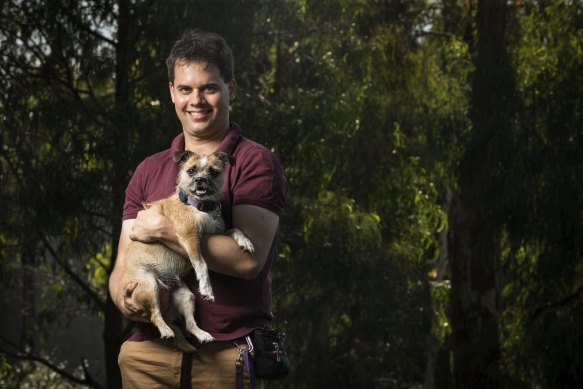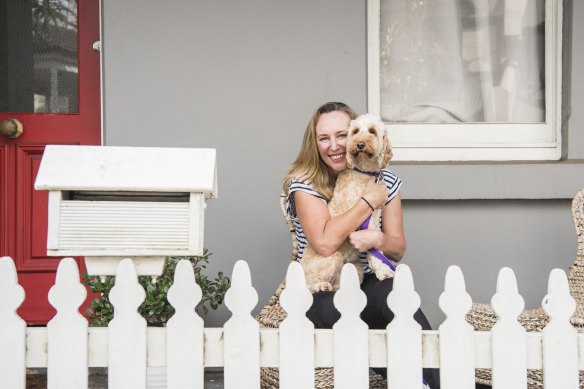This was published 2 years ago
Navigating the return to office life (your dog, not you)
By Larissa Ham
Thought it was difficult to get your child into daycare?
Then try landing a spot in Australia’s most popular doggy daycare centres, where some pooches are reluctantly being turned away due to surging demand.

South Yarra-based Zac Gross and wife Monique spend one or two days at home with their staffy terrier cross Poppy.Credit: Darrian Traynor
With workers heading back to the office more frequently, owners are trying everything to keep their furry offsiders happy – and mitigate any potential separation anxiety. That includes paying up to about $80 for daycare, installing video cameras at home, and stocking up on calming treats and toys.
At Sydney’s Dogs in Town, business has gone barking mad, with the onslaught of rain adding to the mix. Co-owner Jakub Illes says they’re busier than ever. “Some days when we are full capacity, unfortunately we have to say no for comfort of other pups.”
He says many dogs suffer separation anxiety, though some jump in and play straight away. Owners receive Instagram updates while they’re at work.
At Kip, which has 10 daycare centres across Australia, weekly customer calls have jumped 23 per cent since January, with trial days up 52 per cent.
“If we can relieve the anxiety in the owners, it actually does go some way to relieving the anxiety in the dogs.”
Sam Mendelson, general manager of daycare operations at Kip
“We do have to turn away dogs. Kew [in Melbourne] is one that is pretty chockers at the moment,” says general manager of daycare operations Sam Mendelson, who notes the Brunswick and Bayswater centres are also rapidly filling up.
He says dogs that have had good socialisation can adapt pretty quickly to their owners returning to work, but “COVID pups” – who are not so used to interacting with the world – may struggle.
In South Yarra, Zac Gross and wife Monique are trying to ease their staffy terrier cross Poppy, who they got in October 2020, into a new normal.
“We don’t let her run our lives, but we always try and make sure we’re not leaving her alone for too long,” says Gross. “Between my wife and myself we spend one or two days a week at home and the ‘grandparents’ do a bit of babysitting.”
They have resisted the temptation for a camera, but are not averse to leaving a YouTube channel for dogs on for Poppy.
Gross says he’ll miss the quick cuddles during his work day – but not so much the cheeky interruptions to his Zoom calls.
In Sydney’s Balmain, Yvette Peverell, who works at Coastrek, has started going back to the office two days a week, and will miss her spoodle Libby.
“She has been such a great companion throughout lockdowns and is not used to being alone for long stretches of time, so I just want to make it as easy for her as possible.”
Given her workplace is focused on fitness, Peverell says Libby will be welcomed on team walks during the occasional visit to the office. At other times, she’ll employ a local dog walker.

Yvette Peverell and her spoodle Libby outside their Balmain home.Credit: Steven Siewert
Tim Watson, a dog trainer and behaviorist at Good Dog Behaviour and Training, says dogs are often sensitive to small changes in routine.
If they suffer separation anxiety, he says it “looks a bit like the human equivalent of a panic attack”.
And there might be some very obvious signs, such as crying and destroying the house.
Watson says dogs are highly social animals and need to learn to be comfortable through small successions.
For example, you could teach your dog to stay on a mat while going about your household routine so they get used to being apart from you, he says.
If you have an old phone, Watson suggests filming your dog while you head out for a bit, to see how they’re coping.
For highly stressed dogs, it’s worth getting a dog walker, trying daycare or getting someone to sit your dog during the day – at least temporarily, he says.
Meanwhile, Sam Mendelson says the anxiety can go both ways.
“If we can relieve the anxiety in the owners, it actually does go some way to relieving the anxiety in the dogs because the relationship is so close,” he says.
And if owners decide to use daycare for their dogs, he says they may need to exert some “self-control”.
“Just like kids, if an owner is anxious at drop-off, and doesn’t want to leave the dog, sometimes that anxiety can transfer to the dog.
“If you’re not feeling confident, then you’re best to just leave quickly and they’ll be fine once you leave.”
Make the most of your health, relationships, fitness and nutrition with our Live Well newsletter. Get it in your inbox every Monday.